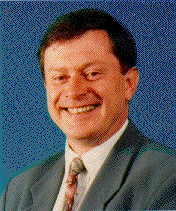Volume 13, Issue 1, 1999

Editorial
Welcome to Volume 13 of CHEER.
CHEER continues to evolve and, I hope, to improve. We welcome three new members to our Editorial Board, reflecting better the journal's international scope and coverage. From Germany we are joined by Harald Mattfeldt and Holger Paetow, both from the Hochschule fuer Wirtschaft und Politik, Hamburg (Hamburg School of Economics and Political Science). From South Africa we welcome Kathy Munro of the University of Witwatersrand.
Holger has published in CHEER, most recently this time last year in the form of his paper "Long-Run Dynamic Market Equilibrium Simulation through the use of Spreadsheets" (CHEER Volume 12 Issue 1). Both Harald and Holger came to the CALECO 98 conference last September and, as well as presenting a paper there, took part in a number of interesting and thought provoking informal discussions. This issue of CHEER includes a brief report from them on CAL activities in Germany, and there will be more to come from them in future issues.
Kathy was also at the CALECO 98 conference, and she too has contributed to CHEER before (see the paper she wrote on "CAL, apartheid and economics education at South African Universities" with Jason Probert in CHEER Volume 9 Issue 3). We look forward to more news from her in the future about the development of CAL in Economics in South Africa.
There is much to be gained from greater world-wide co-operation between economists who make intensive use of computers and communications technology in their teaching and research. By my reckoning there have already been contributions to CHEER from people in nine different countries (the UK, US, Australia, Canada, South Africa, Germany, the Netherlands, Spain and Singapore). I look forward to receiving papers and reports for publication in CHEER from countries which have not so far been represented.
This issue of CHEER includes two more papers which illustrate the imaginative use of spreadsheets in teaching. Lisa Wilder makes a case for introducing the concepts of stationarity and parameter constancy in the context of a study of consumers' expenditure carried out using Excel. Even if students go on to take more advanced courses in econometrics and macroeconomics, and progress to working with more specialised econometrics software, there may still be advantages in introducing such important ideas for them to explore in a software environment with which they are familiar, using a tool which they perceive to be useful to them after graduation. This is followed by a paper by David Whigham and Jeanie Whyte, who show how the display facilities of Excel can be used to enhance the presentation of inter and intra industry flows in a more visual way than the customary tabular format.
Simon Mardle and Sean Pascoe provide a thorough review of the genetic algorithm software which is available for the solution of optimisation problems, beginning with a general introduction to the whole area of genetic algorithms and ending with an illustration in the context of a fisheries bioeconomic model. I chip in with a paper on the production and use of on-line quizzes in economics on the web. The paper reviews some of the software tools which are available for the creation of such quizzes and points to some of the quizzes on the web that you might like to use with your students.
Simon Price gives us an update on the latest version of WinEcon. Andy Beharrell and the other developers of the Virtual Economy give us more details on this exciting project which was first outlined in the last issue of CHEER. Congratulations to the team, who have received good coverage in the press, and on the radio and TV for their work.
As always we have a report from the CTI Centre for Economics. We also again have one on the CAI sessions at the ASSA conference in America. I couldn't get there myself this year, but I am pleased to say that the organisers Betty Blecha and Tod Porter (who are also on our Editorial Board) have produced an excellent summary of this year's proceedings. Ros O'Leary provides a report from Australia where she was "stagestruck" at the ASCILITE 98 conference.
- Guy Judge
- Department of Economics, University of Portsmouth
The next issue of CHEER, Volume 13 Issue 2, will be published in September 1999.
The final deadline for copy is Friday 20th August, but papers (which are refereed) must be with me by Friday 9th July. Articles, short notes, reports and reviews and other material submitted for publication should be presented in a well recognised electronic format, preferably MS Word or WordPerfect files with graphics files in .gif format. They should be sent on disk to the Editor, Guy Judge, at Portsmouth, or as e-mail file attachments to Guy.Judge@port.ac.uk. Contact me by e-mail first if you are unsure whether the format you wish to use will be acceptable.

